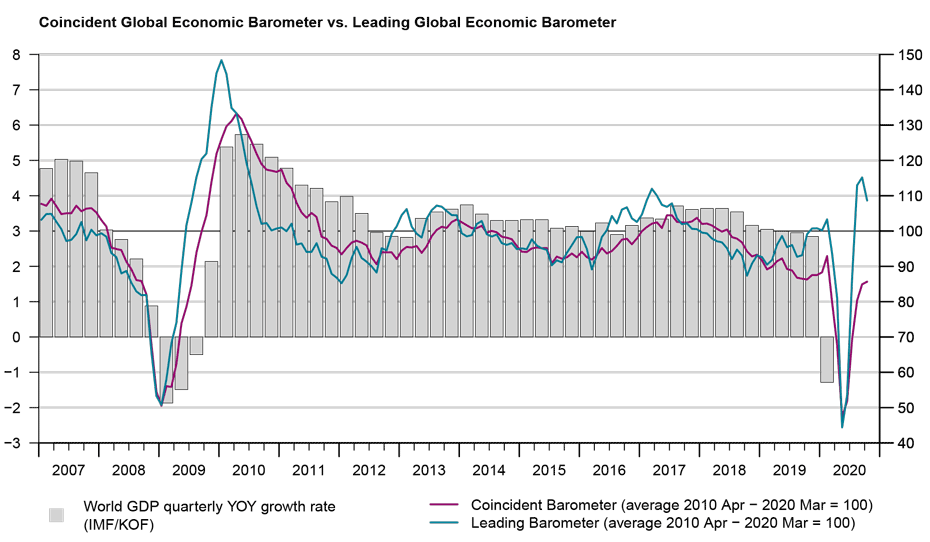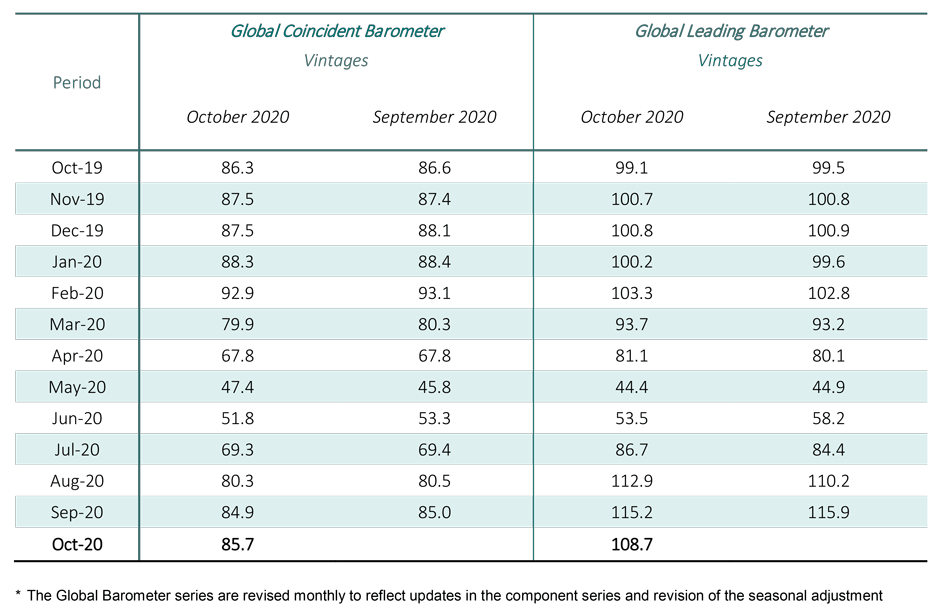Global Economic Barometers: Weakening Momentum
The Coincident and Leading Global Economic Barometers move in opposite directions in October. The Coincident Barometer maintains a rising tendency, albeit at a clearly slower pace than in the previous months. Despite its decline, the Leading Barometer continues to show a recovery in global GDP. The slowdown, respectively decline in the indicators suggest that after a first strong rebound, the pace of recovery is to weaken.
The Coincident Global Barometer records a slight increase of 0.8 points in October, rising from 84.9 to 85.7 points. The Leading Global Barometer, meanwhile, falls by 6.5 points this month, from 115.2 to 108.7 points. This indicates a weakening of optimism after the rise of more than 70 points in the previous four months. The slower rise in the Coincident Barometer is caused by a negative contribution from the Asia, Pacific and Africa region, while positive contributions come from Europe and the Western Hemisphere. The Leading Barometer decreases in all three investigated regions, while the strongest contribution to the aggregate result comes from Asia, Pacific and Africa.
“The pandemic situation currently varies from region to region. While some countries seem to have the number of infections under control, others are experiencing a resurgence of cases, including some areas in Europe. The uncertainty associated with this is reflected in the slowed dynamics of the barometers. The retail trade and services sectors, among others, appear to be affected by this development, contributing negatively to both barometers”, says KOF-director Jan-Egbert Sturm.
Coincident Barometer – regions and sectors
After its rise from June to September, the Coincident Barometer for the Asia, Pacific and Africa region declines in October, contributing negatively to the Global indicator with -1.5 points. Europe and the Western Hemisphere regions (North America, Latin America and the Caribbean) both contribute positively, with 1.0 and 1.3 points, respectively. The Western Hemisphere continues to be the only region to return to the pre-pandemic level of February 2020, which it achieved in September. Europe has almost reached the pre-pandemic level in October, while the Asia, Pacific and Africa region remains 14.6 points below this reference. The graph below illustrates the contribution of each region to the deviation of the Coincident Barometer from the historical average of 100 points.
The highest contribution to the increase in the Coincident Global Barometer in October comes from the set of variables reflecting the aggregated development of economies (Overall Economic Development), followed by Construction, which contributes modestly, and Industry, which remains constant. Variables from the Trade and Services sectors contribute negatively to the result.
Leading Barometer – regions and sectors
The Leading Global Barometer leads the world economic growth rate cycle by three to six months on average. In October, the highest negative influence stems from the Asia, Pacific and Africa region, contributing -4.5 points (or 68%) to the Global indicator. After the indicators of the region recovered from the worst losses of the pandemic in August and September, they now return to a lower level than before the pandemic. Europe also contributes negatively to the fall with -1.2 points, although it remains highly optimistic, recording 140 points. The Western Hemisphere indicator shows a revision of underlying expectations as well and contributes negatively to the Leading Barometer with -0.9 points.
After contributing positively in the previous four months, Industry contributes negatively by -5.6 points in October. As in the Coincident Barometer, Trade and Services contribute negatively to the result. This month, only the set of variables reflecting the aggregated development of economies (Overall Economic Development) and Construction contribute positively to the result of the general indicator, albeit to a small extent.
The full press release with table and graphs can be found Download here (PDF, 521 KB).
More information on the Global Economic Barometers can be found here.
The Global Economic Barometers
The Global Economic Barometers are a system of indicators that enables a timely analysis of global economic development. They represent a collaboration between the KOF Swiss Economic Institute of the ETH Zurich in Switzerland and Fundação Getulio Vargas (FGV) based in Rio de Janeiro, Brazil. The system consists of two composite indicators: a Coincident Barometer and a Leading Barometer. The Coincident Barometer reflects the current state of economic activity. The Leading Barometer, on the other hand, gives a cyclical signal that is roughly six months ahead of actual economic developments.
The two Barometers comprise the results of economic tendency surveys conducted in more than 50 countries. The aim is to achieve the broadest possible global coverage. Advantages of economic tendency surveys are that their results are usually available quickly and they are not substantially revised after the first publication.
The Coincident Barometer includes more than 1,000 different time series, while the Leading Barometer comprises over 600 time series. Cross-correlation analysis is used to decide which individual time series are included in the barometers. This involves correlating the individual time series with a reference series. The reference series used is the year-on-year growth rate of global gross domestic product (GDP), where the individual national GDPs are aggregated at purchasing power parity to form global GDP. A time series is only included in a Barometer if it shows a sufficiently high correlation and a suitable synchronisation or lead with the reference series.
The two Barometers are calculated once every month. They are usually published at the 10th of each calendar month. They are therefore available at a monthly frequency and in a timely manner.

